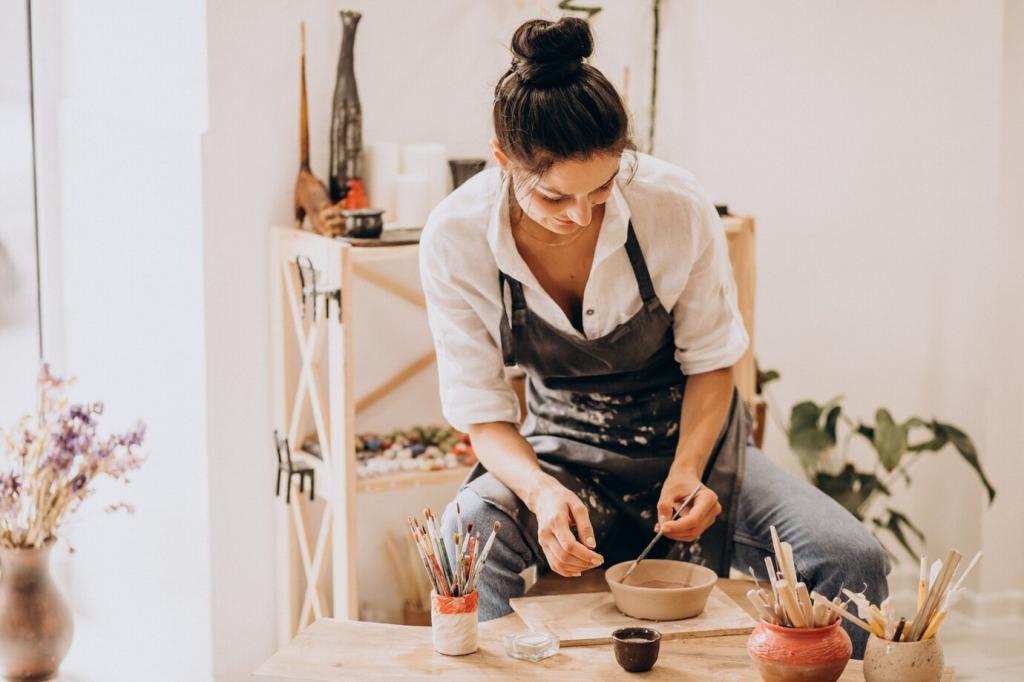Artisan-Style Candle Making Techniques
Chosen theme: Artisan-Style Candle Making Techniques. Step into a world where wax, wick, and scent become a personal signature. Learn refined methods, mindful workflows, and soulful details that transform simple materials into candles with presence, character, and a story worth sharing.

The Soul of the Artisan Pour
01
Artisan pouring is not rushed. You read the wax like a mood—watching temperature, viscosity, and clarity, adjusting gently. That slow dialogue helps prevent flaws, deepens consistency, and produces a candle that feels calm even before the wick is lit.
02
Many artisan journeys begin in cramped kitchens with thrifted jars and borrowed thermometers. Each careful pour becomes a tiny celebration of progress, teaching that authentic technique grows through repetition, curiosity, and the courage to keep refining details others might overlook.
03
Craft thrives on conversation. Share your first successful pour temperature, your funniest wax mishap, or the scent that hooked you. Comment below and subscribe for monthly artisan techniques, field-tested experiments, and soulful prompts to keep your creative flame burning bright.
Wax Wisdom: Beeswax, Soy, and Blends
Beeswax Glow and Bloom Control
Pure beeswax offers a golden flame and gentle honeyed aroma. Manage natural bloom by controlled cooling and soft polishing, rather than aggressive heat. Filter carefully to remove minute debris, respecting the wax’s origin and preserving its clean, cathedral-like glow.
Soy Silks and Frosting Tactics
Soy’s velvety finish pairs beautifully with subtle fragrances. Reduce frosting by moderating temperature differences between wax and vessel, and cooling gradually. When frosting appears, embrace its organic look or lightly pass a heat gun to smooth, then allow ample, peaceful curing time.
Custom Blends for Signature Throws
Blend soy with a touch of coconut or beeswax to balance adhesion, melt pool speed, and scent throw. Keep meticulous notes on ratios and pour temperatures. Incremental tweaks often unlock the consistent, elegant burn profile that defines your distinctive artisan candle line.
Wick Alchemy: Sizing, Priming, and Centering
Measure vessel diameter, wax hardness, and fragrance load to select a wick that develops a steady melt pool without mushrooming. Conduct burn tests in three-hour cycles, trimming between sessions, and record flame height, soot, and jar temperature to dial in perfection.


Wick Alchemy: Sizing, Priming, and Centering
Pre-waxing a wick helps it stand true, catch flame swiftly, and burn more evenly. Use a firm adhesive to anchor tabs, employ centering tools or cross-sticks, and confirm alignment after the initial contraction as the wax begins its quiet, cooling descent.
Color, Texture, and Botanicals
Liquid dyes disperse evenly in container candles, while micas shine in wax melts but may clog wicks when burned. Test for UV fade, keep color loads modest, and let hue serve the story rather than overpowering the subtle poetry of scent and flame.

Molds, Vessels, and Release Techniques
Silicone, Metal, and Hand-Carved Molds
Silicone captures fine textures and releases gently with patience. Metal molds conduct heat quickly for crisp edges. For hand-carved or vintage molds, pre-warm lightly, avoid force, and let time do the work—your best release tool is a calm, measured approach.
Upcycled Vessels, But Safety First
Repurposed glass and ceramics add character. Confirm they are heat-safe, free of hairline fractures, and thick enough to dissipate warmth. Preheat to minimize wet spots, avoid lids during initial cures, and keep an eye on thermal shock when pouring in cooler seasons.
Share Your Favorite Finds
Have you discovered a perfect vintage tumbler or stoneware cup that sings with beeswax? Tell us where you hunt and how you test. Comment your vessel wins, and subscribe for field notes on sourcing and safety that keep creativity—and containers—intact.


Finishing, Curing, and Burn Testing
Soy often blossoms after several days, coconut blends come forward quickly, and beeswax rewards patience. Note room temperature and airflow, label test jars with dates, and observe how fragrance cohesion improves when you resist the temptation to light too soon.
Finishing, Curing, and Burn Testing
Address sinkholes with a gentle second pour, smooth tops with a measured heat gun sweep, and trim wicks to a crisp eighth-inch. Small rituals add up to refinement, turning a good candle into one that feels composed, confident, and genuinely handcrafted.
Troubleshooting the Artisan Way
01
Tunneling, Mushrooming, and Soot
Tunneling often signals an undersized wick or rushed first burn. Mushrooming suggests too large a wick or heavy fragrance. Combat soot with proper trimming and balanced wick selection. Change just one variable per test so you know exactly what truly helped.
02
Wet Spots and Sinkholes
Wet spots arise from wax pulling from cool glass; pre-warm vessels and cool slowly. Prick sinkholes, then top off with a small repour. Track room temperature, vessel prep, and pour temperatures to reveal repeatable strategies rather than single-use fixes.
03
Community Wisdom
What persistent problem did you finally solve, and how? Share your hard-won insights so another maker can avoid tears and wasted wax. Comment below, ask questions freely, and subscribe for deeper dive tutorials anchored in real artisan experiments and measured outcomes.
